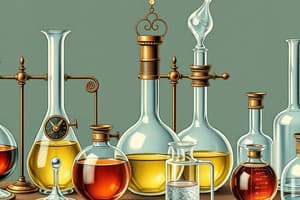Podcast
Questions and Answers
What is the primary use of a crucible in a laboratory setting?
What is the primary use of a crucible in a laboratory setting?
- To cut glass rods
- To heat certain solids, particularly metals, to very high temperatures (correct)
- To support porcelain crucibles during heating
- To heat beakers containing hot liquids
Which equipment would you use to provide a stable elevated platform for reactions being heated?
Which equipment would you use to provide a stable elevated platform for reactions being heated?
- Crucible tongs
- Wire gauze
- Iron rings (correct)
- Utility clamps
What is the function of the clay triangle in laboratory procedures?
What is the function of the clay triangle in laboratory procedures?
- To light Bunsen burners safely
- To securely hold crucibles over a Bunsen burner (correct)
- To act as a surface for semi-micro scale experiments
- To support glass plates during reactions
Which statement is true regarding the use of beaker tongs?
Which statement is true regarding the use of beaker tongs?
Which type of clamp would you use to secure a buret during titration?
Which type of clamp would you use to secure a buret during titration?
What is the primary purpose of a graduated cylinder in a laboratory setting?
What is the primary purpose of a graduated cylinder in a laboratory setting?
Which laboratory tool should never be used to transfer solid chemicals directly with bare hands?
Which laboratory tool should never be used to transfer solid chemicals directly with bare hands?
Why should a wash bottle only contain distilled water?
Why should a wash bottle only contain distilled water?
In what scenario would gas collecting bottles be utilized?
In what scenario would gas collecting bottles be utilized?
What is the role of rubber stoppers in a laboratory setting?
What is the role of rubber stoppers in a laboratory setting?
What is a feature of the Florence flask that distinguishes it from other lab containers?
What is a feature of the Florence flask that distinguishes it from other lab containers?
What type of paper is utilized to identify acidic substances?
What type of paper is utilized to identify acidic substances?
Which laboratory instrument is primarily used for stirring solutions?
Which laboratory instrument is primarily used for stirring solutions?
Flashcards are hidden until you start studying
Study Notes
Laboratory Equipment Overview
- Beakers are designed for holding solids or liquids that do not release gases during reactions and are safe to stir or heat.
- Erlenmeyer flasks can contain solids or liquids that may produce gases or splatter, thanks to their conical shape.
- Florence flasks are less common in first-year chemistry, featuring a narrow neck to minimize splash exposure during mixing.
Measurement and Collection Tools
- Graduated cylinders measure liquid volumes accurately.
- Gas collecting bottles capture large volumes of gas produced by displacement of water.
Holding and Cleaning Tools
- Test tube holders enable safe handling of hot test tubes.
- Test tube brushes clean test tubes and graduated cylinders, but excessive force can break fragile glassware.
- Test tube racks organize test tubes on surfaces, with caution against plastic racks melting when in contact with hot glassware.
Sealing and Reaction Platforms
- Rubber stoppers prevent spillage and contamination; heating containers with stoppers is risky.
- Spot plates facilitate multiple small-scale reactions simultaneously.
- Watch glass holds small quantities of solids, often the result of reactions.
Stirring and Dropping Tools
- Glass stir rods are used for manual stirring and transferring small amounts of liquid.
- Medicine droppers transfer small liquid volumes (under 1 mL) and have a rubber bulb for easy dispensing.
Identification and Precision Instruments
- Litmus paper comes in red for identifying bases and blue for acids.
- Forceps act as tweezers for picking up small laboratory items.
- Funnels help transfer liquids from one vessel to another.
Pipetting and Washing Tools
- Mohr pipets are calibrated for accurate liquid delivery.
- Wash bottles deliver distilled water or wash solutions precisely to specific areas.
Weighing and Dispensing Instruments
- Weighing boats are used for weighing solids before transferring them.
- Spatulas dispense solid chemicals from their containers safely without direct hand contact.
Heating Equipment
- Beaker tongs, designed for handling hot beakers, secure hot glassware during experiments.
- Bunsen burners heat nonvolatile liquids and solids efficiently.
- Evaporating dishes are suitable for heating stable solids.
- Crucibles withstand very high temperatures for heating certain solids, especially metals.
Supports and Safety in Heating
- Clay triangles support porcelain crucibles over Bunsen burners.
- Crucible tongs safely handle hot crucibles and other hot items, not intended for beakers.
- Glass plates serve as surfaces for semi-micro experiments or chemical testing.
Ringstands and Support Equipment
- Ringstands provide a stable platform for reactions requiring heat.
- Iron rings attach to ringstands, creating elevated workspaces for reactions.
- Utility clamps secure glassware like test tubes to ringstands.
- Double buret clamps hold burets for titration use.
- Wire gauze provides support for beakers, with older variants potentially containing asbestos.
- Pressed fiber pads protect countertops from hot beakers.
Ignition Tools
- Strikers facilitate the ignition of Bunsen burners; operate sparingly to avoid wasting flint.
Studying That Suits You
Use AI to generate personalized quizzes and flashcards to suit your learning preferences.



